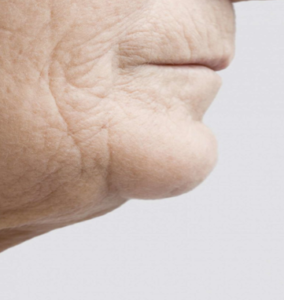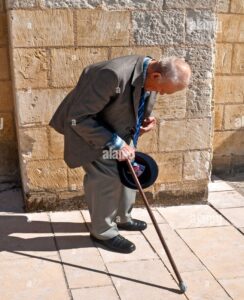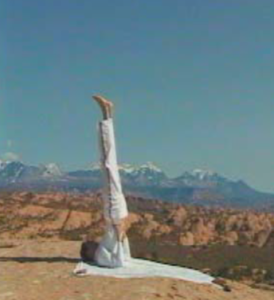Consider the sagging chin and the sagging skin on the face. All are gravity’s assault on the body as we age. Yes, gravity keeps us attached to the Earth. But it also constantly pulls us down. Our skin wrinkles and sags. The chin sags. Our stomach sags. Our legs take on varicose veins as the blood struggles over time to flow back up to the heart and brain. Our hair turns gray. The brain weakens in its ability to concentrate and remember as the rich, oxygenated blood is first drawn down to the legs, diminishing the brain of life’s replenishing nutrients.
Then consider how we shrink in height and stature. Gravity pulls the head and shoulders toward the ground as we age, some more dramatically than others. There are those who say such “shrinking” has caused them to lose inches to their frame, as they are unable to stand straight and erect any longer. Consider one of the more pronounced effects of this in the photo below.
The next question I often hear after answering the question of why regularly being upside down is so important is, “Do I really have to stand on my head?”
John in a headstand in 2017.
Of course not. The purpose of being upside down for seconds (and then minutes) each day is that more rich, oxygenated blood flows to the head and the hair bringing more of its nutrients there. It relieves the pressure on the veins of our legs. It pulls the skin, stomach, and chin in the opposite direction. One can do a shoulder stand to create the inverted position. One can support themselves on a wall for greater balance and protection when doing an inverted pose. The importance is not how cool we look or how much we can do, but that we find a way to invert our body each day and combine it with proper stomach breathing while in an inverted position.
John in a shoulder-stand 1999
Finally the question of “How long should I remain in an inverted position?” That will vary with each of us. But I recommend counting the number of breaths you feel comfortable with in the pose. Never do it (or any tai chi yoga movement) longer than you are comfortable! Over time, you can increase the number of breaths you remain in an inverted position. I could tell you how many breaths I take while in an inverted position, but that is not what’s important. Your body will tell you what’s best for you. But anything is better than nothing.




